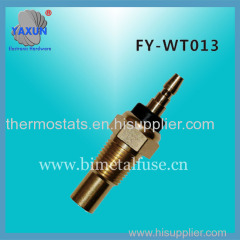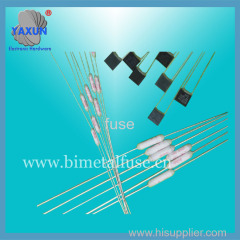
|
Dongguan Yaxun Electronic Hardware Product Co., Ltd
|
250v 10a thermal protector fuse
| Price: | 0.02 USD |
| Payment Terms: | T/T,L/C,D/A,D/P,WU,Paypal,Money Gram |
| Place of Origin: | Guangdong, China (Mainland) |
|
|
|
| Add to My Favorites | |
| HiSupplier Escrow |
Product Detail
Temperature fuse Brand: TAMURA / Tamura, Albemarle, NEC, Emerson / Emerson, Emerson, Japan, Panasonic / Matsushita, Xingyu, JingKe, PANASONIC
Technical Parameters And terminology Of Thermal Fuses
(1) Rated operating temperature (Tf):
The temperature fuse is tested according to the standard method to change the temperature of its conductive state. According to IEC6091 standards-based security provisions, the temperature fuse must be operated within the rated operating temperature + 0 / -10 ° C (the Japan Electrical Supplies Act provides a tolerance range of ± 7 ° C).
(2) Operating temperature Found:
The temperature fuse is heated in the silicone oil tank at a rate of 0.5-1 ° C per minute, detection current is less than the fusing temperature measured at 10mA condition. It is the actual operating temperature of the temperature fuse.
(3) Holding temperature (Th):
When the temperature fuse passes the rated current, can hold for 168 hours without changing the maximum temperature of its conductive state.
(4) limit temperature (Tm):
Temperature fuse can withstand the maximum temperature for 10 minutes reconnection phenomenon never occurs.
(5) Rated current (Ir):
The maximum current that the temperature fuse can carry.
(6) Rated voltage (Ur):
Temperature fuse maximum operating voltage.
Precautions For Use Of Thermal Fuses
The thermal fuse is a sensitive protective element, in the use of the process, need to pay attention to some specific parameters, the use of the correct installation method in order to properly use the product, Can reduce the risk of improper operation of the temperature fuse caused by incorrect design and installation methods.
Design And Selection Criteria:
1, each temperature fuse has its rated electrical characteristics and temperature parameters, the product must be used within the specified rated parameters.
These parameters include Tf (rated operating temperature), Th or Tc (hold temperature), Tm (limit temperature) and rated current, voltage, see "Temperature fuse specification table" for details.
2, the installation design should pay attention to the temperature fuse of the long-term continuous working environment temperature should not exceed their holding temperature.
3, the temperature of the temperature of the fuse body due to power and cause their own fever and higher than the ambient temperature. Depending on the installation method and status, the rising temperature may be higher, it is recommended to use a thermocouple to test the temperature of the heating element at the time of design, and then determine the rated temperature of the temperature fuse and the mounting position.
4, the temperature fuse is a non-resettable thermal protection device, for safety reasons, when replacing the temperature fuse, use the same type of temperature fuse and install it in the same position.
The Mounting Position Of The Thermal Fuse
● When designing the product installation position, let the temperature fuse close to the heating body, the temperature fuse should be installed in the machine prone to failure, abnormal heat the most sensitive position.
In order to increase the sensitivity of the temperature fuse to temperature, need to make the temperature fuse and heat a larger area of contact.
For example, the motor coil is fitted with a thermal fuse:
When used on motor windings, if possible, the temperature fuse should be buried in the coil winding, speed up the heat conduction, improve the sensitivity of the temperature fuse.



















